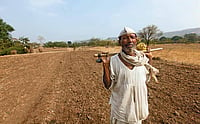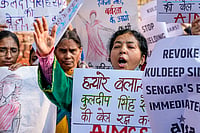The mildly pungent smell around Shahaji Tapase’s house in Jawaharnagar, Kolhapur, makes one think leather work is on. But it’s the smell of the past. He used to run what’s known as a “bag tanning” unit: the hides and tanning ingredients are sewn up in a bag, hot water poured in and left till the tanning is completed. At his closed dukan, a picture frame of a Hindu god and another of ‘786’ with the backdrop of a mosque hang from a pillar. It’s from units such as Tapase’s that the leather for the famous Kolhapuri chappals is sourced.
With business in decline for several years now, the communities involved in all that goes into the town’s eponymous chappals now feel even more cornered because the beef ban has impacted the prices and supply of leather. No threat or violence has been reported here so far, but with the shock of Una incident fresh in memory, manufacturers and labourers are afraid it’s not long before the last nail is hammered in the coffin. Already they report a 20 per cent drop in supply of hide and an increase in the price of buffalo hide from Chennai.
Traditionally, the world-famous chappals are prepared by some Scheduled Caste communities—Chambhar, Dhor and Mahar-Maang. Carcasses are picked by the Mahar-Maangs and handed over to the Dhors for the month-long processing, during which hide is treated with dye from the babool and hirda plants. Finally, the Chambhars make the chappals, distinguished by their ear-flaps, tassels, patterning, stitching—and their susurration at each footstep because of the layers of leather making up the sole. Prices range from Rs 300 to Rs 10,000 or more.
But manufacturers and workers have almost given up. Arun Satpute, founder and chairman of the Kolhapuri Chappal Audyogik Samuh (Kolhapuri Footwear Industry Group), has one of the larger units in town. He sees no future. “To be honest, we have been in decline for years, but this government, which may be influenced by the RSS, seems to work for only certain kind of people. For people from our communities...the decision directly impacts our livelihood,” he says.
Around 14,000 workers are engaged in making Kolhapuris, and the trade has cottage industry status. Most families have been at it for generations; but now, hardly anyone wants his children to continue the line.
At Satpute’s unit in Subhasnagar, 8-10 workers who’ve been at the trade for 20-30 years are scraping, cutting, hammering and stitching the tanned leather and working it into chappals. The rhythm is backgrounded by music from a transistor radio. Nobody discusses the beef ban. Shubhangi Kamlakar, one of the workers, says things will get worse. “We have to work with chemically processed leather from Chennai because organic tanning has stopped. And now even that is expensive. What are we to do?”
Tapase shut his unit two years ago after a court order on water pollution. “As if that wasn’t bad enough, now we don’t even get enough supply for processing. Even if we process only buffalo skin, it is not easy to get them,” says Tapase, who now sends the hides to Karnataka. Around 10-12 units have closed in the past couple of years, he says.
Around 1,000 Dhor families in and around Kolhapur are also affected by the ban. “I don’t know how those whose livelihood is linked to carcasses are surviving,” says Tapase. He is referring to the Mahar-Maang, who live a little away from villages, since the richer castes won’t let them mingle. The ban is a marginalisation of the already marginalised.
by Prachi Pinglay-Plumber in Kolhapur


























